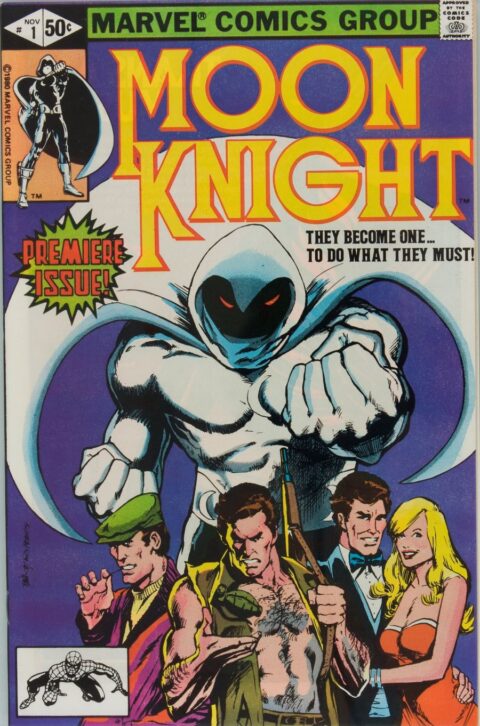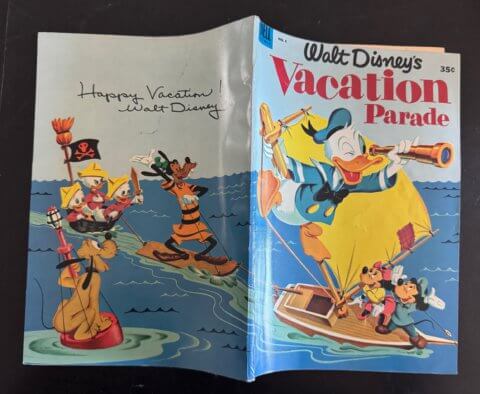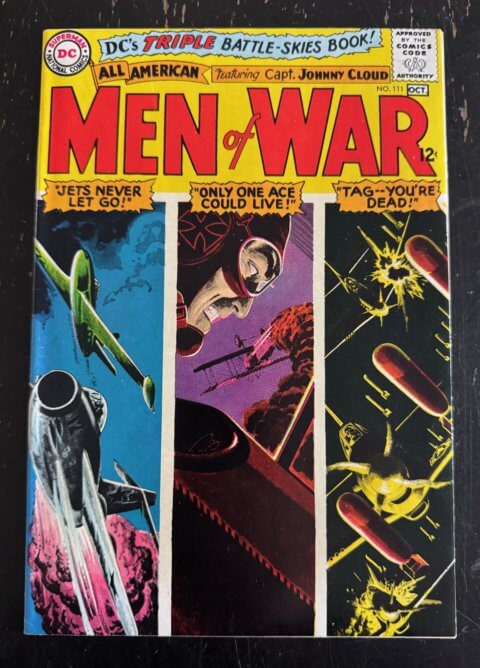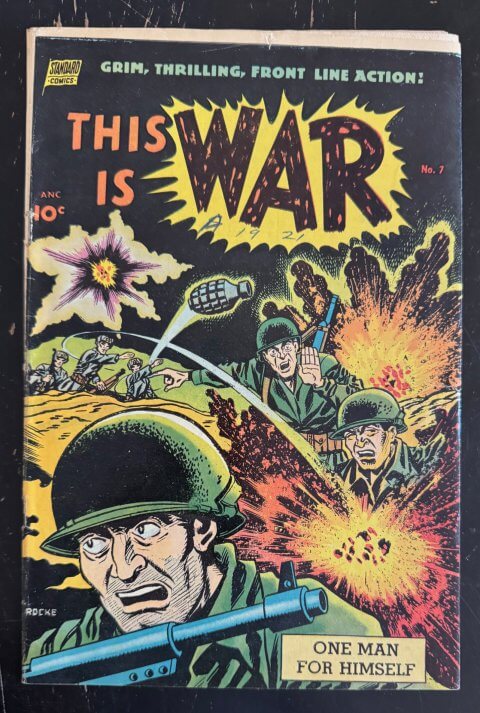I’ve been selling early Copper Age books like crazy this year, the hottest era at my shop. Key issues from around 1980 are on fire, Moon Knight #1, She-Hulk #1, Rom #1, even books like Star Wars #39 and dare I say Micronauts #1 are flying off my back issue wall at a rate that I cannot replace. I can’t say the same for Silver and Bronze Age and the current hot books seem to be selling to a bit of a different crowd, for the time being at least. That core group of old comic collectors though have really taken to this early Copper Age, in a big way.
These early Copper Age books actually started getting hot a few years ago, those sellers that brought to market the first wave of CGC 9.8s made off like bandits and thought they were taking candy from babies. The thing is that recent prices have been rivalling those early scarce offerings even with ten times the supply.
Time does its thing and marches on and it’s only natural that this Copper era follows in the footsteps of the early 70s Bronze Age with its massive collectors base. I can only make the assumption that this early Copper Age stuff is now securing a very large collector base, actually at the rate they are flying out the store I’m certain of it. These early Copper Age books are so easy to collect too, you can get raw copies of the grails for around $100 and for CGC 9.8 you’ll maybe have to go past $500 on a very select few. What’s great about this eras too is that there are lots and lots of key issues that you can go searching for and build yourself quite an impressive collection and at a fraction of the cost of amassing a similar Bronze Age Collection.
We are venturing into uncharted territory here though in terms of supply and future supply. Until the Copper Age, every other age has had a similar distribution system and thus similar factors affecting the post-distribution supply. Comic books up into the mid-1970s were mostly distributed through newsstands and corner stores, drug store comic racks etc. Proprietors couldn’t wait to send back the unsold copies to receive their credit. As the decades went by comic book collecting became more and more popular and more and more kids kept their books in the form of collections, caring for them and preserving them for us to fight over today. By 1980 comic collecting was a big thing.
By 1980 though there was also this new network of Specialty Comic Book shops across North America that ordered tons of comics but never returned them. We have now entered into the age of boxes and boxes of store overstock. These early Copper Age books would be some of the earliest suspects in the store overstock era. Shop owners just kept piling the unsold books into long boxes and found room in basements, backrooms and even off-site storage facilities. It has been four decades since 1980 so you’d think that most of these overstock long boxes have long been pilfered and raided? Most maybe but not all.
Copper Age comics is an era of comics that is now being heavily collected, this era’s relatively plentiful supply should keep prices in check to a degree thus making the era even more collectible. The Copper Age might just develop into the most approachable of eras to collect.





You also have the nostalgia factor kicking in with a lot of the kids who bought these books hitting their 40’s and now have disposable income to chase their childhoods.
I’m torn. I love selling some of my collection since I feel like prices are so ridiculously inflated (you can absolutely take one of my 1st Carnage appearances for $200) but it’s killed a lot of the love I used to have for the medium. I’ve found myself going back and buying a lot of end of copper-early modern books that I still have deep connections to. It’s also helped me appreciate some very underrated runs.
I’ve been watching a lot of the books in this era over the past year to see how the market would react with a lot of earlier keys just hitting that point where they’re priced out for a lot of people. It’s wild to see how much some of these books have appreciated in value having just spent the better part of 3 decades in $1 or $5 bins.
For the most part at the beginning of the 80’s I was still only collecting golden age comics. By the end of the 80’s I was back at comic stores and collecting the ‘new’ grim and gritty like Watchman and the Dark Night and a bunch of indies… so these other Copper Age titles are really new to me by anything but name.
Hey Tim I know what you mean re the 1st Carnage, the problem is we think we’ll buy it back next year at half the price but the thing keeps going up! And as for what point they’ll price themselves out still has to play out. As I mentioned in my post above these are really the 1st wave of comics to potentially have huge store stock inventories yet to hit market. I do think the key issues have more room to appreciate, collectors will keep coming to these books over the next 5 years at least.
Gerald, you make a good point when you say those gritty late 80s books because that’s when it all changed. These early 80s books were kind of forgotten and not even considered for the longest time. I look at the copper age like I look at that second wave of classic rock in the late 70s, everybody loves the Stones, Floyd, The Who, The Beatles etc and then everybody points to Punk and Disco as the change over but just near the end there bands like Foreigner and April Wine!
Walter !
one small point of contention with me is you stating that the Copper Age started around 1980 . to me , the Bronze Age lasted up to 1985 , when Crisis started .
my very first Overstreet I bought was number 4 , the Don Newton cover of the JSA ! I read that book so much it fell apart on me a couple of years later . one of the most important bit of information I gleaned from it was that the Silver Age Marvels most valuable books were the first ten issues of every title .
so , starting in 1976 until 1983 , I bought ten copies of every new Marvel title up until its’ tenth issue . I also bought 3 copies of every DC title until its’ fifth issue . it is now appearing to have been a smart move . like the titles you’ve mentioned , I also have recently pulled some DC’s , All-Star Comics 58 and 69 , Batman 300 , DC Superstars 17 . etc .
I’ve sent them to CLINK for pressing and grading . most came back in 9.8 with white pages , some in 9.6 with white pages , they’ve done very well for me . I’m thinking of holding on to the rest for a few more years , just to see where they’re heading for ! hopefully up , still .
you are correct , at the last few shows here in Vancouver before Covid-19 hit , they were selling very briskly . even Harley Yee was selling them quickly , and his books are not cheap to buy !
That’s some forward thinking Chris, nice word, and I’m glad you’re keeping some back. Harley is the James Brown of comics, the hardest working man in the business.
So this grading thing… how do you know the comic you sent out for grading is the one you got back as it’s now in a slab? As I buyer, how would I know that a $49,000-$220,000 Amazing Fantasy 15 or any high collectable (Captain Marvel, Batman, whatever) isn’t a laser copy cover wrapped around a poor grade Sugar&Spike, or whatever, or blank newsprint or is complete? Just curious. Maybe it’s my trust issues and cynicism but If I had that kind of disposable money I wouldn’t be doing it on online, it’d be in person and I’d still have to see the comic in question, all of it, but the slabs shouldn’t be cracked.
Seems these days the value is held in the slabbing, not the comic. Last week’s newly printed comic, in a slab, 3+ digit figure. Oh, I’m so not positive : )
Thanks for the 10 first issues tip, interesting, though I’m probably too old to start this sort of thing. Be more for my family’s benefit (?) or I could just leave the cash in the bank. However having said that, I just bought my third Golden Age comic on trust from a Canadian seller online, a Whiz Comics appearing to be in nice shape but not slabbed, for a price in my budget. Just to have one in my collection, for fun, and to read.
Cheers!
That should be I bought a Captain Marvel, #137 CM battles the Seven Deadly Sins cover.
Tim, as key comic graded issues soar, I assure you that frauds will occur when 100,000’s of dollars occur. There are documented frauds in the baseball card industry, Im certain there will be one day soon in this industry, I wonder how often CGC has run into this ? Any stories that you know of Walt?
I sent a beautiful Amazing Spiderman #6 down 15 to 20 years ago for grading. It was an easy cgc 8.5 to 9.
It came back as a 4.5.
A huge thumb sized shape had been torn from back cover as some one obviously carelessly removed it from its fitted slip. No one took ownership and I hadn’t taken pictures. lesson learned. Lucky a good guy name Walt D took it off my hands. Thanks Walt.
It also drives me crazy Tim how a small color touch incurs a restoration label but a heavily taped issue doesn’t.
Dave !
try this trick … I had my presser remove the small colour touch on my 9.2 restored grade from cgc , he then sent it in himself , it still came back a 9.2 , but this time as an universal grade , which made me an extra $1500 USD on the book . sneaky , yes , but , it works on a small colour touch !
I still find it incredulous that pressing is now a ‘thing’ prior to comic grading and encapsulation. I recall many years of Overstreets, warning that comic pressing was considered a defect, and that people should never have their comics pressed.
I guess that, next, I’ll be reading how everyone is now polishing their old coins up to a like-new shine, using acidic cleaners and scrubbing.
My, how times change.
The market is a powerful force Klaus, if upgrading your early Marvel key but a half grade can earn you more money then you’ll pay that guy to iron out that crease. So far buyers seem to be buying pressed books as still original and unrestored, so far.
On a similar tack, I also remember the hubbub raised when the comics all became variants in the 80s. Canadian price variants were especially frowned upon and Overstreet had to reassure collectors that all price variants would always be equal and that the CPVs wouldn’t be undervalued when compared to the US price variants and direct market stuff.
Now, CPVs are the holy grsil. Even FECA books, which were viewed as the US versions’ poor cousin, now command prices above those of the US versions, even though they have crappier quality covers and interiors, off-register printing, missing stories, less pages and incorrect story content with mismatched covers.